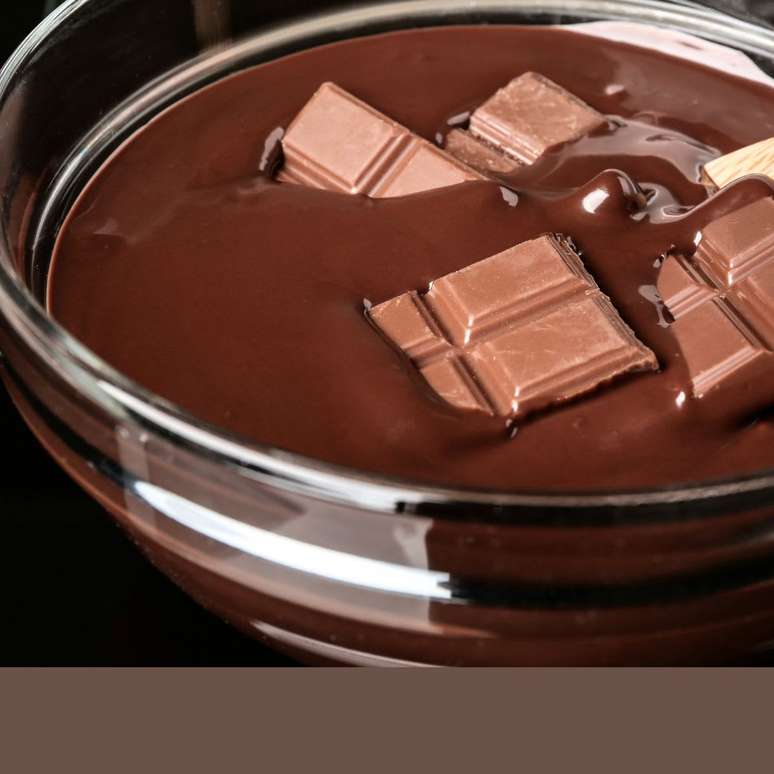Learn how to work chocolate correctly: understand crystallization, techniques and temperatures
Discover the main techniques and working temperatures for tempering chocolate and obtaining a perfect result
Recipe for 2 people.
Classic (no restrictions), Vegetarian
Preparation: 00:30
Interval: 00:10
TOOLS
1 cutting board(s), 1 bowl(s) (use non-metal microwave safe), 1 whisk, 1 spatula(s), 1 spatula(s) – for tempering chocolate on stone (optional), 1 culinary thermometer
EQUIPMENT
conventional + microwave
METERS
cup = 240 ml, spoon = 15 ml, teaspoon = 10 ml, teaspoon = 5 ml
Ingredients HOW TO SEASON CHOCOLATE – (choose the chocolate you prefer for your recipe):
-white chocolate to taste
– milk chocolate to taste
-semi-sweet chocolate to taste
PREPARATION:
Tempering chocolate seems difficult, but it’s actually a matter of controlling time, temperature and movement.
The product must be of high quality and contain a good percentage of cocoa. Always choose chocolates by observing the composition of the packaging – they must not contain hydrogenated fats, this is not part of good chocolate – make sure by reading the labels.
Time and temperature are crucial and movement is part of one of the processing methods in precrystallization and consists of moving to cool the chocolate, keeping it in contact with the cold surface.
Having a cooking thermometer for this preparation is essential. Temperatures must be controlled correctly.
PRECRYSTALLIZATION:
-
Pre-crystallization consists of carrying out the process of multiplying the stable chocolate crystal through the process of melting, cooling and obtaining the ideal working temperature, based on the type of chocolate used.
-
When made correctly, the final product has a satin sheen, with perfect color (no blemishes) and that characteristic “break” or “taper”, with that little noise known as a “pop”.
Crystallization process/tempering temperatures:
-
First you need to increase the temperature to 45°C-50°C, at which point the chocolate will be completely melted. To do this you can melt the chocolate in a bain-marie, being careful not to touch the water in the bowl and not to let the water fall into the chocolate. The second option is to use the microwave, placing the product in a non-metallic bowl and adjusting the power to medium and turning on the device at short intervals – every 30 seconds or every minute, until the chocolate softens.
-
Next, the chocolate needs to be cooled to 27°C – at which point it becomes denser, as its temperature has dropped.
-
To crystallize the temperature must rise from 27°C to the target temperature, which varies depending on the type of chocolate.
-
White: 27°C to 28°C
-
with milk: from 29°C to 30°C
-
Semi-bitter and bitter: 31o C to 32o C.
PREPARATION:
TEMPERING/CRYSTALLIZATION METHODS:
1. Marble/Stone Method:
- Melt the chocolate, pour 2/3 of the quantity onto the stone, keeping the rest in the hot container and work with back and forth movements, so that most of the chocolate is in contact with the cold surface, until the temperature drops to 27° C. .
- Continue until the chocolate begins to thicken, normally – when its temperature is 4-5 degrees lower than the working temperature – it means that crystallization is taking place. At this point, watch out for the “peaks” that form as you drop the chocolate from the spatula.
- Add the chocolate at 27°C to the bowl with the remaining ⅓. Measure the temperature again and heat, if necessary, to the working temperature of the chocolate (white, milk or dark).
two. Sowing method:
- The sowing method is to melt 90% of the amount of chocolate.
- Then cool it by adding the reserved chocolate (10%) to room temperature.
- After mixing the reserved chocolate, heat the entire mixture to working temperature.
3. Mary Bath Method:
- It’s a simple method and has the advantage of not making a lot of mess, but it tends to take longer.
- Melt the chocolate in a bain-marie.
- Next, place the container with the melted chocolate upside down in a bain-marie (in a bowl full of ice) until the temperature drops.
- And then bring it to the desired/working temperature by placing it in a bain-marie again (it only takes a few minutes, always measure it with a thermometer).
4. Method of adding cocoa butter (Mycryo):
- This is the simplest and most expensive method.
- The addition of 1% cocoa butter is expected (in relation to the quantity of chocolate). This causes the addition of stable crystals instead of their proliferation (multiplication).
- To do this, the chocolate must be melted to 45°C and cooled to 33°C (milk chocolate) and 34°C (semi-sweet, dark chocolate) – it is not necessary to increase the temperature again.
CRYSTALLIZATION TEST:
- After precrystallization, test with a spatula.
- Place some chocolate on the spatula and place it in the fridge.
- When it cools, check the brightness, color and “breakage” to see if you have obtained a quality product.
FINALIZATION AND ASSEMBLY:
- After tempering, the chocolate can be placed in the molds and acquired the desired shapes, for Easter eggs, bon bons, gingerbread, etc.
- Use your creativity and explore this technique how to temper chocolate to produce incredible recipes.
Do you want to make this recipe? Access the shopping list, HERE.
To see this recipe for 2, 6, 8 people, Click here.
Create your personalized menu for free on Bake and gourmet cakes.

Source: Terra
Ben Stock is a lifestyle journalist and author at Gossipify. He writes about topics such as health, wellness, travel, food and home decor. He provides practical advice and inspiration to improve well-being, keeps readers up to date with latest lifestyle news and trends, known for his engaging writing style, in-depth analysis and unique perspectives.






![Such a wonderful sun in advance: Summary of the Episode on Monday, Monday, Monday 22, Monday, September 22, Monday [SPOILERS] Such a wonderful sun in advance: Summary of the Episode on Monday, Monday, Monday 22, Monday, September 22, Monday [SPOILERS]](https://fr.web.img6.acsta.net/img/29/2a/292a2052bcdfc4ca2838ac8d80b3f296.jpg)


